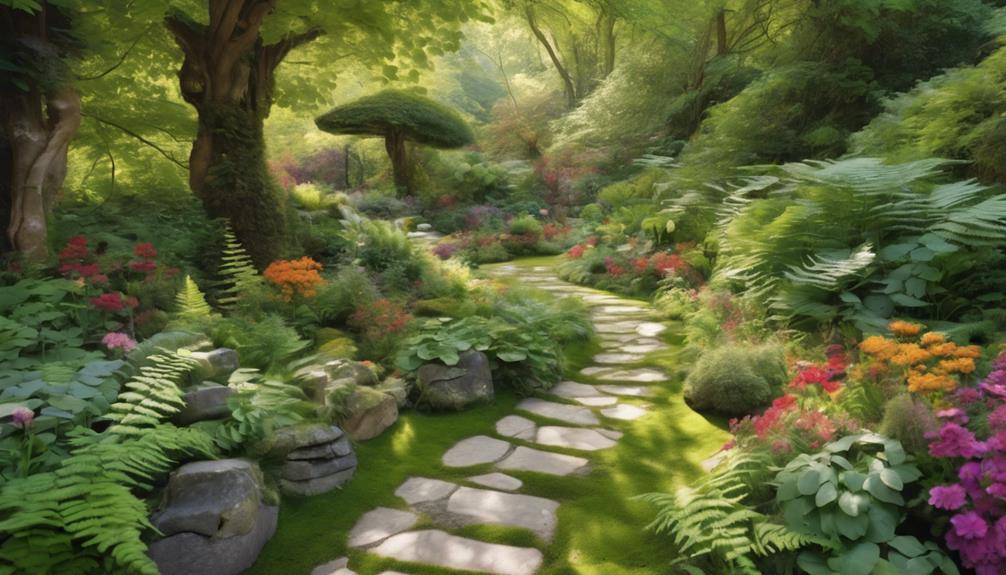
What Are the Benefits of Custom Stone Pathways?
20 October 2024
Simple Hardscaping Maintenance Tips for Homeowners
20 October 2024Custom stone pathways significantly enhance the aesthetics and functionality of gardens, creating inviting spaces that can increase property value.
By selecting durable materials such as flagstone, slate, or limestone, you can achieve visual appeal while ensuring longevity and low maintenance.
Thoughtful designs, whether geometric or organic, guide visitors through your outdoor oasis, integrating seamlessly with existing features to create a sense of harmony.
Safety and accessibility are paramount, so consider non-slip textures and adequate width for mobility.
With expert planning and installation, your custom pathway can transform your garden into a stunning retreat.
Explore further to uncover the best strategies and materials for your project.
Pathway Design Options Available
When considering custom stone pathways for gardens, various design options can enhance both functionality and aesthetics.
Selecting from a range of natural stone choices allows for unique textures and colours that complement the landscape.
Furthermore, incorporating geometric layout ideas can create striking visual patterns, guiding visitors through the garden with elegance.
Natural Stone Choices
Natural stone choices for garden pathways offer a variety of design options that can enhance both aesthetics and functionality. Among the most popular stones are flagstone, slate, and limestone, each providing unique textures and colours that can elevate the visual appeal of your landscape.
Flagstone, with its irregular shapes, allows for organic layouts, while slate presents a more refined, uniform finish. Limestone offers a classic look with its warm hues, perfect for rustic settings.
When selecting natural stone, consider factors such as durability, maintenance, and integration with existing garden elements. Furthermore, the choice of stone can influence drainage and accessibility, ensuring that your pathways not only beautify your garden but also serve practical purposes effectively.
Geometric Layout Ideas
Designing garden pathways with geometric layouts can transform outdoor spaces into visually striking areas that are both functional and inviting. Incorporating shapes such as squares, rectangles, circles, and hexagons can create a dynamic flow throughout the garden.
For instance, a series of rectangular pavers arranged in a herringbone pattern can lead the eye while ensuring stability and ease of navigation. Alternatively, circular layouts can soften the harsh lines of traditional designs, promoting a more organic feel.
Utilising contrasting materials, such as polished stone with rough textures, can enhance visual interest and guide visitors. Ultimately, the key to successful geometric pathways lies in harmonising the layout with the entire garden design, ensuring both aesthetic appeal and practical functionality.
Material Selection Importance
The selection of materials for stone pathways in gardens is essential for ensuring durability and aesthetic coherence.
Considerations such as weather resistance, visual appeal, and safety features play a significant role in the overall functionality and attractiveness of the pathway.
A thoughtful approach to material choice not only enhances the garden's design but also promotes accessibility for all users.
Weather Resistance of Materials
Selecting materials with ideal weather resistance is vital for the longevity and functionality of custom stone pathways in gardens. The right choice not only guarantees durability but also enhances the overall investment.
Consider these significant factors when selecting materials:
- Moisture Resistance: Opt for stones that minimise water absorption to prevent cracking and erosion during freeze-thaw cycles.
- UV Stability: Choose materials that resist fading and degradation from sun exposure, maintaining their aesthetic integrity over time.
- Slip Resistance: Prioritise stones with textured surfaces that provide traction, particularly in wet conditions, to improve safety and usability.
Aesthetic Appeal of Pathways
Material selection plays a pivotal role in achieving the desired aesthetic appeal of custom stone pathways in gardens.
The right materials not only enhance visual interest but also harmonise with the surrounding landscape.
When choosing stones, consider the following:
- Colour Palette: Select stones that complement the existing flora and architecture, creating a cohesive look.
- Texture: Incorporate a variety of textures to add depth and intrigue, from smooth flagstones to rugged cobblestones.
- Shape and Size: Utilise diverse shapes and sizes to create a dynamic pathway that guides the eye and invites exploration.
Safety and Accessibility Considerations
How can the choice of materials impact the safety and accessibility of custom stone pathways in gardens?
Selecting appropriate materials is essential for ensuring that pathways are both functional and secure.
Consider the following factors:
- Surface Texture: Materials with a non-slip surface reduce the risk of slips and falls, particularly in wet conditions.
- Evenness: Choosing stones that can be laid flat prevents tripping hazards, promoting safe navigation for all users, including those with mobility challenges.
- Durability: Weather-resistant materials maintain structural integrity over time, ensuring that pathways remain safe and accessible, regardless of environmental factors.
Planning Your Pathway Layout
Effective pathway layout begins with an initial site assessment to identify key features of your garden.
Following this, employing ideal stone placement techniques ensures both aesthetic appeal and functionality.
Furthermore, incorporating curved path designs can enhance the natural flow of the landscape, creating a more inviting atmosphere.
Initial Site Assessment
A thorough initial site assessment is vital for planning a stone pathway layout that complements the existing garden design. This evaluation not only informs the aesthetic choices but also ensures functionality and longevity.
Key considerations during the assessment include:
- Topography: Analyse the slope and contours of the land to determine the most suitable pathway route, avoiding drainage issues.
- Soil Composition: Identify soil type to understand its bearing capacity and drainage characteristics, which are critical for stone placement.
- Existing Flora: Take note of existing plants and landscaping features to integrate the pathway harmoniously, enhancing both form and function.
Optimal Stone Placement Techniques
Careful consideration of ideal stone placement techniques is vital for creating a functional and visually appealing garden pathway. Effective planning guarantees not only aesthetic harmony but also maximum usability.
Here are three fundamental strategies to master your stone placement:
- Alignment: Ensure stones are aligned for a cohesive look; straight lines convey formality, while staggered placements create a more relaxed feel.
- Spacing: Maintain consistent spacing between stones to facilitate easy navigation and a balanced appearance. A gap of 5-10 centimetres is often optimal.
- Surface Leveling: Properly level the substrate before placement. This prevents shifting and maintains a stable pathway, enhancing both safety and longevity.
Incorporating Curved Path Designs
Incorporating curves into garden pathways can greatly enhance the overall aesthetic and functionality of the space. Curved paths create a sense of movement and intrigue, guiding the viewer's eye through the landscape.
To effectively plan your curved pathway layout, consider the following:
- Natural Flow: Align the path with existing landscape features to create a harmonious design.
- Width Variation: Vary the width of the path to increase visual interest and accommodate different uses.
- Material Selection: Choose stones that complement the overall design while ensuring durability and traction.
Increased Property Value
The aesthetic appeal of custom stone pathways can considerably enhance a property's value, making it a prudent investment for homeowners. These pathways not only improve the visual landscape but also create a welcoming environment, which can attract potential buyers. Below is a representation of how custom stone pathways can influence property value:
| Feature | Impact on Value | Example |
|---|---|---|
| Unique Design | Increases desirability | Curved stone paths |
| Durable Materials | Low maintenance cost | Granite or limestone |
| Eco-friendly Options | Attracts eco-conscious buyers | Recycled stone |
| Improved Accessibility | Enhances functionality | Pathways to gardens |
| Visual Cohesion | Complements landscaping | Harmonised colours |
Investing in custom stone pathways is not merely an enhancement; it is a strategic move to boost your property's market appeal.
Gardening Pathway Installation Techniques
When installing custom stone pathways, several critical techniques ensure both functionality and aesthetic appeal.
Effective pathway lighting enhances safety and visibility, while proper weed control methods maintain a clean and attractive surface.
Furthermore, sealing the stone not only improves its appearance but also extends the pathway's longevity against environmental wear.
Pathway Lighting Installation Techniques
To enhance the beauty and safety of custom stone pathways in gardens, effective pathway lighting installation techniques are essential.
Proper illumination not only improves aesthetics but also ensures safe navigation during twilight hours.
Consider the following techniques for optimal results:
- Layered Lighting: Utilise a combination of ambient, task, and accent lighting to create depth and drama along the pathway.
- Strategic Placement: Position lights at regular intervals, focusing on highlighting edges and turns to guide visitors without overwhelming the space.
- Energy Efficiency: Opt for LED fixtures that consume less power and have a longer lifespan, thereby reducing maintenance and energy costs.
Weed Control Techniques
Effective pathway lighting enhances the visual appeal of bespoke stone pathways; however, maintaining these pathways requires attention to weed control techniques.
Weeds can undermine both the aesthetic and structural integrity of your pathways if not managed properly. Here are three effective strategies for controlling weeds:
- Pre-emergent Herbicides: Apply these products in early spring to prevent weed seeds from germinating, ensuring a tidier pathway.
- Mulching: Employ organic or inorganic mulch around the stones to suppress weed growth while enhancing the decorative aspect of your pathway.
- Regular Maintenance: Frequent inspections and hand-pulling of any emerging weeds can significantly reduce their spread, allowing your stone pathways to truly shine.
Sealing for Longevity
Ensuring the longevity of your custom stone pathways involves the crucial step of sealing the stones after installation. This process not only protects the stones from environmental wear but also enhances their aesthetic appeal.
Consider the following key benefits of sealing:
- Water Resistance: A quality sealant prevents moisture infiltration, reducing the risk of cracking and erosion.
- Stain Prevention: Sealants act as a barrier against spills and organic materials, preserving the natural colour and texture of the stones.
- Ease of Maintenance: Sealed pathways require less frequent cleaning and upkeep, allowing for a beautiful garden with minimal effort.
Drainage Issues and Remedies
Effective management of drainage issues is essential for maintaining the integrity of custom stone pathways in gardens.
Addressing uneven ground levels and stones not only improves aesthetics but also prevents water accumulation and erosion.
Numerous techniques and solutions exist to ensure proper levelling, thereby promoting ideal drainage and prolonging the pathway's lifespan.
Uneven Ground Leveling Techniques
Uneven ground presents significant challenges in creating custom stone pathways, affecting both aesthetics and functionality.
To effectively address these issues, consider the following levelling techniques:
- Soil Compaction: Compacting soil can stabilise the ground, reducing the risk of settling and ensuring a firm foundation for your stones.
- Excavation and Filling: Remove high spots and fill low areas with a suitable material, such as gravel or sand, to achieve a more level surface.
- Retaining Walls: Constructing retaining walls can help manage slopes and provide support for the pathway, preventing erosion and improving drainage.
Implementing these techniques will not only enhance the structural integrity of your stone pathways but will also contribute to the overall attractiveness of your garden space.
Uneven Stones Leveling Technique
After addressing the challenges of uneven ground, the next concern often arises from the stones themselves. Uneven stones can lead to significant drainage issues, impacting the longevity and aesthetics of your pathway.
To effectively manage these challenges, consider the following remedies:
- Assess Stone Placement: Regularly inspect the positioning of stones to identify any shifting that may disrupt drainage.
- Incorporate Gravel: Utilise a layer of gravel beneath the stones to facilitate proper drainage and prevent pooling.
- Adjust Surrounding Soil: Ensure that the soil surrounding the stones slopes away, directing water flow and minimising erosion.
Uneven Stones Leveling Solutions
Addressing the issue of uneven stones is vital for maintaining a functional and visually appealing garden pathway.
Proper drainage is critical to prevent water accumulation, which exacerbates unevenness. Here are three effective solutions to consider:
- Re-grading the Base: Adjust the underlying soil to create a slight slope away from the pathway, ensuring proper runoff.
- Utilising Aggregate Fill: Incorporate gravel or crushed stone beneath the uneven pavers, allowing for better drainage and stability.
- Installing Drainage Channels: Implement French drains or surface drains alongside pathways to redirect water flow and minimise erosion.
Why Choose TKL Birmingham Gardener
Choosing TKL Birmingham Gardener for your bespoke stone pathways guarantees a blend of expertise and artistry that transforms ordinary gardens into extraordinary landscapes.
With years of experience, our skilled artisans meticulously design and install pathways that not only enhance the aesthetic appeal of your garden but also ensure durability and functionality.
We utilise high-quality materials, tailored to complement your unique landscape, while employing cutting-edge techniques that deliver precision in every project.
TKL Birmingham Gardener prioritises client collaboration, ensuring that your vision is realised with meticulous attention to detail.
Our commitment to excellence is reflected in the seamless integration of pathways that guide the eye and foot alike, creating harmonious outdoor spaces that elevate your gardening experience to new heights.
Common Pathway Maintenance Questions
Maintaining the beauty and functionality of custom stone pathways is key to preserving the investment made in your garden's design. Common questions often arise regarding their upkeep.
Initially, how often should pathways be cleaned? Routine maintenance, ideally every few months, prevents the accumulation of debris and moss, ensuring longevity.
Secondly, what cleaning solutions are safe? Mild soap mixed with water is effective; avoid harsh chemicals that could damage the stones.
Thirdly, how can weeds be controlled? Implementing a landscape fabric beneath the stones can greatly reduce weed growth.
Moreover, sealing the stones every few years improves durability and prevents staining.
Final Thoughts on Pathways
The allure of custom stone pathways lies not only in their aesthetic appeal but also in their ability to enhance the overall functionality of a garden space.
These pathways serve as fundamental elements that augment both the beauty and usability of outdoor environments.
When considering the implementation of stone pathways, keep in mind the following:
- Design Integration: Ensure that the pathway harmonises with the existing landscape, creating a seamless flow throughout the garden.
- Durability: Opt for materials that withstand environmental conditions, ensuring longevity and minimal maintenance.
- Safety and Accessibility: Design pathways that provide safe access, accommodating all users while preventing erosion and other landscape issues.
Incorporating these elements will elevate your garden, transforming it into a well-structured sanctuary.



